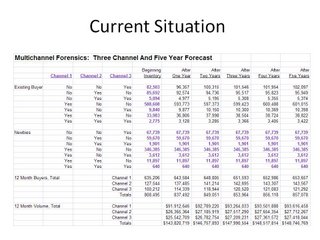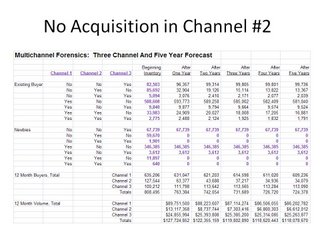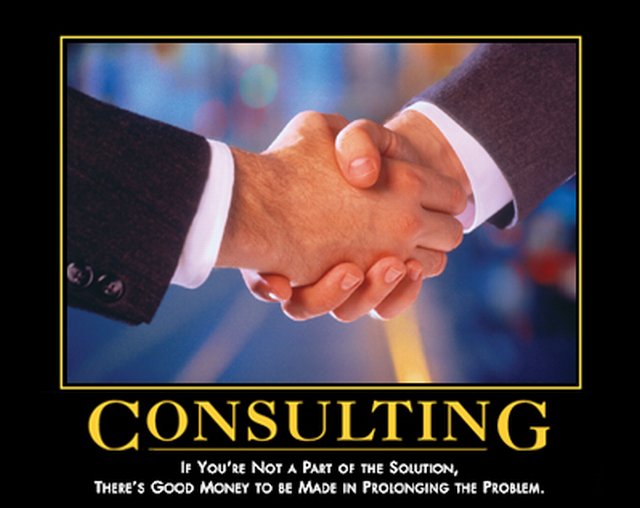 It is time to Skype-in and hear feedback from the Gliebers Dresses Executive team.Glenn Glieber (Owner): "... and there she was, Anna Carter herself, standing in the same Starbucks line that I was standing in. You should have seen her face when she found out that I pre-paid for her mocha!"
It is time to Skype-in and hear feedback from the Gliebers Dresses Executive team.Glenn Glieber (Owner): "... and there she was, Anna Carter herself, standing in the same Starbucks line that I was standing in. You should have seen her face when she found out that I pre-paid for her mocha!"
Meredith Thompson (Merchant): "Kevin, is that you?"
Kevin: "Yup, it is me!"
Glenn Glieber: "Good, glad you are here. We wanted to let you know what we thought of your presentation and recommendations.
Meredith Thompson: "First of all, we really liked the idea of testing smaller catalogs. Honestly, we are still amazed that half of our housefile business will happen if we stopped mailing catalogs today, we don't quite know how to wrap our heads around that. But because Sarah's team executed the test and you sign off on the results, we need to seriously think about the implications. We're not convinced that reducing contact frequency is good, but we do think smaller page counts could be beneficial."
Sarah Wheldon (Marketing): "And we think it is a good idea to reduce frequency among customers with an e-mail address. So we're going to accept your recommendation to reduce frequency from twenty-four to twelve mailings a year for customers who possess an e-mail address."
Lois Gladstone (Finance): "You also convinced us that we must not cut customer acquisition any further. We understand that we lose half of our customer base each year, so we must acquire new customers."
Roger Morgan (Operations): "But we also realize that we're being killed by having $12.95 shipping and handling, and we cannot afford to offer inexpensive shipping and handling to everybody all of the time. So we want to become as competitive as we can, given where our business currently is."
Lois Gladstone: "So we decided that we are going to implement a new program. Any customer who orders and keeps four dresses will receive free shipping and handling for the remainder of the year."
Sarah Wheldon: "We think this strategy gives us a chance to compete with online brands that take market share by offering low price dresses coupled with free shipping."
Roger Morgan: "And it gives us a chance to move volume into the first half of the year, allowing us to not have to lay off contact center and distribution center employees."
Lois Gladstone: "Your data suggested that if we can achieve a 10% increase in productivity, the program will generate a ton of profit over the next twelve months. We need a ton of profit over the next twelve months. Once the business is fixed, we'll be able to afford to go after new customer acquisition."
Kevin: "What data are you using to validate your assumption that you'll achieve a 10% increase in productivity over the next twelve months?"
Roger Morgan: "Here in my hand I have a research report I purchased yesterday morning from Woodside Research. They surveyed 1,129 consumers. 58% of consumers said that participation in a loyalty program caused them to have a more favorable relationship with the brand, and 87% of consumers loved receiving discounts and promotions as part of a loyalty marketing strategy."
Sarah Wheldon: "It could be that this strategy changes customer perception. Our shipping and handling is just too expensive, so this might be a way to re-engage customers."
Meredith Thompson: "And I want to completely eliminate all barriers to purchasing merchandise. The merchandise should stand on its own merits, it shouldn't be harmed by shipping and handling practices. This loyalty program makes it all about the merchandise. If the customer demonstrates loyalty to us, we'll eliminate shipping and handling expense for them."
Pepper Morgan (Creative): "We haven't talked about your micro-site idea, yet. We think there might be merit to that idea. I'd really like to tackle the concept of a micro-site for the 15-39 year old customer audience. I think that is a great idea, one that would be a lot of fun!"
Meredith Thompson: "I'm really concerned about that idea. Kevin, you fail to factor branding into this equation. Gliebers Dresses stands for quality, value, and service. When you create a micro-site, you create a new brand. I don't want to alienate our existing customers. Our existing customers have an expectation of the quality, value, and service that we'll deliver. Why make it hard for the customer to shop this merchandise by re-branding it as a separate micro-site? I don't get it?"
Roger Morgan: "In a recent Neptune Research report, 1,340 consumers were surveyed. 61% of consumers want brands to create an integrated multichannel shopping experience. A separate micro-site takes us in a direction opposite of an integrated multichannel shopping experience."
Sarah Wheldon: "I don't necessarily think that a micro-channel website is a bad thing, it can be a good thing if we can find new ways to market to younger customers. But I'm worried about the catalog opportunity. A separate micro-site might dictate a new catalog strategy, and we don't have the resources to produce catalogs for this customer audience."
Pepper Morgan: "But we wouldn't market to these customers with catalogs, we'd simply find new ways to market to customers."
Sarah Wheldon: "Do we think that these customers are going to magically show up at our website? We have to do something to drive the customer to the website."
Pepper Morgan: "Kevin said that bow-tie-guy's test indicates that half of our sales happen organically, without the aid of marketing. How do you explain that?"
Sarah Wheldon: "We had to advertise to those customers at one point to acquire the customer, and then to develop brand loyalty. All of that advertising created a situation where the customer might be willing to shop today, without the aid of advertising."
Kevin: "Who would own the marketing initiatives for a micro-site?"
Meredith Thompson: "Oh, that one is easy. I'd own the merchandise assortment, Pepper would own the look and feel of the website, Sarah would own all marketing initiatives, and Roger would own site maintenance and site improvements."
Kevin: "Who would own final decisions? For instance, if Pepper wanted to put videos up on YouTube, who would make that call?"
Pepper Morgan: "I'd make that call."
Sarah Wheldon: "That's my call, that's a marketing initiative."
Roger Morgan: "Well I think I own that call. That video shouldn't go up on YouTube, it should be prioritized into my book of work, and my team would publish the content on the micro-site when resources permit it to be published. I want the SEO juice that comes from the video, I don't want YouTube to get that. Since I'm accountable for making our site natural-search friendly, I should own the decision to have the video on my site."
Lois Gladstone: "I'm not certain we have the budget to put broadband-quality video on our website."
Pepper Morgan: "If I had to wait two months to put a video up, when I can publish the video on YouTube this afternoon, I'd publish the video on YouTube this afternoon. And then I get around expense issues, it doesn't cost us anything to publish the video on YouTube."
Sarah Wheldon: "And who would market that video for you? That's why this is in my area of responsibility, this is why I need to own this process. I need to make sure that catalogs and e-mails support the video via a multichannel advertising strategy."
Pepper Morgan: "Honestly, I don't need your advertising support, and I cannot wait to publish the video three months from now so that we can add a page to the catalog to market the video. As part of this launch, my entire team will develop a social media presence, and we'll advertise it ourselves. I don't think we need traditional marketing to market this video, we'll do it ourselves."
Sarah Wheldon: "Social Media doesn't work. We only have a couple hundred followers on Twitter. Two hundred views on YouTube doesn't do anything to drive sales."
Pepper Morgan: "Twitter doesn't work if all we do is offer followers 20% off promotions. Twitter will work if we speak to the 15-39 year old customer the way she wants to be spoken to.
Glenn Glieber: "Kevin, you can clearly see here how time-consuming these new initiatives are. We've just wasted an entire executive meeting flapping our gums about something that we may not ever implement. We need to focus on 2% solutions that grow the core brand."
Kevin: "Maybe we can agree to disagree. What you just demonstrated to me is that there is not a clear online marketing leader at Gliebers Dresses. I heard four individuals proclaim partial ownership of a potential online marketing program. This makes it very hard for Gliebers Dresses to move into the future. At the end of this discussion, you discounted the new program, not based on the merits of the new program, but based on how much time you spent taking about disagreements over ownership of the strategy. As a result, you focus efforts on areas like catalog marketing, areas that are slowly becoming less productive, but have clearly defined roles and responsibilities that allow you to work without friction."
Meredith Thompson: "But that's how we've always acted around here. We have vigorous discussions. We allow all voices to be heard. This makes us better. This isn't a dictatorship, Kevin, a multichannel business requires a matrixed approach to management, one where all voices are heard. Leaders have to be good at working in a matrixed relationship."
Glenn Glieber: "Well, another perfectly good hour has been shot on ideas that we may never implement. Kevin, we listened to your recommendations. We're not going to cut back on customer acquisition spending, and we are going to start a loyalty program with the $800,000 you helped save us by reducing catalog mailings to customers who have an e-mail address. I'd say you more than paid for yourself, so we'd like to keep you around for awhile and tap your knowledge as we run into future challenges. We'll chat next week!"
Team: "Thanks Kevin!"
Kevin: "Thanks everybody, have a nice day."
Glenn Glieber: "Ok, it's on to the next item on the agenda. The November catalog currently has 140 pages. I'm hoping to save a few dollars by cutting back to 136 pages. Pepper, could you come up with a creative strategy to still feature 140 pages of merchandise within 136 pages, and Sarah, could you forecast the impact on sales by offering 136 pages to the customer instead of 140 pages? Thanks, everybody!"
Labels: Case Study, Fiction, Gliebers Dresses, Multichannel Forensics









